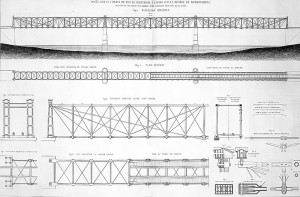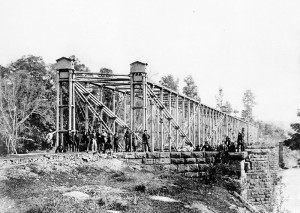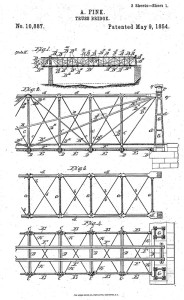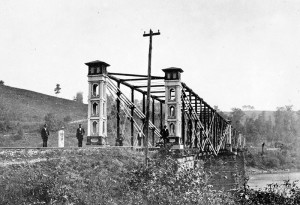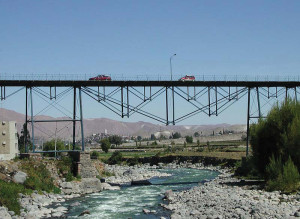After the success of Wendell Bollman’s truss at Harpers Ferry and elsewhere, Benjamin Latrobe encouraged Albert Fink to design a longer span iron bridge that he could use on his major river crossings between Harpers Ferry and the Ohio River. Fink (STRUCTURE, May 2006), after obtaining his engineering degree in Germany, immigrated to the United States in late spring 1849. He went to work on the B&O Railroad working with Wendel Bollman (STRUCTURE, February 2006) and Latrobe. Fink, after reviewing Bollman’s bridge, believed he could improve on that design. His first effort for a cast and wrought iron bridge was similar in appearance and details to Bollman’s. He prepared his drawings, and he and Latrobe decided to enter it into a design competition held in Boston. He wrote in his diary, “The competition is over. We who have brought designs were handsomely entertained. I did not win. Latrobe has taken my defeat greatly to heart. I was surprised when he told me politics influenced the decision.”
Hungerford, in his history of the B&O, wrote a description of Fink’s design method: “The rule of thumb methods that were used in the creation of so many early iron and wooden bridges were hardly to be trusted in the making of an all iron one. So Fink would go to work with pieces of tin and wires, building up trusses in miniature, testing strains and stresses carefully upon these, and from such experiments making his deduction and formulas for the construction of full sized spans.” Based upon this work, Latrobe gave him the project of building a three span bridge across the Monongahela at Fairmont, Virginia (later West Virginia) in 1852. He thought, as did Fink, that Fink’s plan was better suited than Bollman’s for longer spans, and he adopted it for sites requiring such spans. This was Fink’s first bridge and it was the longest span iron bridge in the United States at that time, surpassing Bollman’s span length of 124 feet by 65%.
A four span wooden trestle was built first, to aid in construction and to serve as a temporary crossing. Construction on the masonry piers began in 1850 but was not finished until the end of 1851. Fink’s plan, which may have preceded Bollman’s according to a family biography, consisted of three 205-foot long pinned spans with cast iron upper chords, verticals, lower chord and towers, and wrought iron diagonals and bracing. Many of the details were similar to Bollman’s, since they were both built at the B&O shops. The main difference between Bollman’s and Fink’s trusses was that all of Fink’s long paired diagonals were of equal length. The bridge was 16 feet wide for a single track, had a depth of 20 feet and was built on a skew. It opened in 1852. When building it he wrote home to Germany telling his fiancée Mimi, “I am in complete charge of the building of our bridge across the Monongahela River, a project which will cost $120,000…I cannot help but think often of my colleagues in Germany who are still sitting with their feet under a desk waiting for some opening…”
The difference between a Bollman and Fink Truss was covered in a newspaper article in the Republic and Times newspaper of Buffalo, New York. They wrote, “Mr. Bollman’s plan is entirely different in principle from that of the iron bridge over the canal, near the Erie Depot. This bridge is the Bollman plan. The tension rods are of unequal length, so that for the same expansion there is a different increase in the lengths of the rods sustaining the same point, causing the longer rods to become very loose. This is not the case with the Fink patent – the one selected by Mr. Latrobe. In this bridge, the tension rods are of equal length and, expanding and contracting together, they are kept in proper adjustment at all times. The manner of joining the supporting rods to the uprights upon the piers is also entirely different. This connection is so arranged in the Fink patent that the whole bridge truss is allowed to move freely, thus preventing the strains to which the injurious effects of expansion and contraction are attributable. These two circumstances are sufficient to make up the difference between a very good and a very bad bridge; and we therefore warn all not to confound the two.” In other words, the Fink is the good truss and the Bollman the very bad truss.
On May 9, 1854, Fink received patent #10,887 for a Truss Bridge. It was for both a deck truss and a through truss like he built over the Monongahela River. He claimed,
“I do not claim as new, the manner in which the central post is supported; nor do I claim the combination of a series of triangular bracings, in such a manner, that one system of triangles is supported by and dependent on the other, merely, as I am aware that this has been done before, both in trusses for bridges and roofs. But what I do claim as of my own invention, and as different from any other method of bracing and strengthening bridge trusses heretofore known, is – The method of combining the different systems of triangular bracings, above described, so that a weight coming on one of the systems of the truss, is not only transferred over one or more other systems, before it is carried back to the abutments; but the foot of the post in each triangle, being unconnected with the tension rods of the other triangular bracings, can settle vertically, as well as move to the side; so that the tension rods of each system of the triangular bracings will be strained equally, when the bridge settles under a superincumbent weight. This would not be the case, if the foot of the post in the 2d system of triangular bracings rested on the tension chord of the post, in the first system, as heretofore used; and herein consists my improvement, for which I ask Letters Patent.”
He also noted “the sinking of a portion of the truss by a superincumbent weight, or by changes in the condition of the material used in construction from the effect of temperature, will not cause the several parts of the truss to deviate from their mutual adjustments…” The “first system” he is referring to is the Bollman Truss, which had been patented two years earlier and was being built on the eastern segment of the B&O.
After its opening in 1852, it lasted until 1863 when it was burned by the Confederates during the Civil War. It was replaced with a wooden trestle that lasted until 1865 when two spans were replaced with Fink Trusses. In 1868, the third span was replaced. The trusses were similar to the original, but the new towers were built in an Italianate design. The bridge was replaced in 1887 and again in 1912 when steel Warren Trusses were used. At the time of its construction, it was the longest iron bridge built in the United States with a total length of 615 feet. It, along with Bollman’s, led to a greater trust in the use of iron for railroad bridges. For total length it was only exceeded by Robert Stephenson’s Tubular Bridge in Wales. It received worldwide recognition after its construction. It was never adopted overseas or by other American bridge builders, with the notable exception of C. Shaler Smith and the Baltimore Bridge Company.
Fink left the B&O in 1857 to work on the Louisville and Nashville (L&N) railroad. One of his first efforts was the construction of the Green River Bridge near Mammoth Kentucky. It was a five span deck bridge with the three middle spans being 208 feet and the two outer spans 181 feet. The deck level was 115 feet above the water level in the river. The bridge opened in 1859, but during the Civil War the Confederates blew up the two southerly spans. After the Civil War, the wooden High Bridge over the Appomattox River was rebuilt in 1869 with 21 Fink deck trusses at an elevation of up to 160 feet. His largest bridge was his Louisville, Kentucky Bridge over the Ohio River that opened in 1870. It was the longest bridge (5,250 feet) in the world at the time. It consisted of 25 conventional Fink deck trusses with spans ranging from 50 feet to 245 feet – 5 inches, and two major long-span through trusses of 370 feet and 400 feet, plus a side mounted swing span over the Louisville and Portland Canal. His and Bollman’s trusses were generally built between the early 1850s up until the post Civil War period, when Whipple Double Intersection Trusses in cast and wrought iron, and later steel, became the standard railroad trusses until the end of the century.
Only two of Fink’s bridges survive in the United States. The first was constructed in approximately 1870 as a railroad bridge and converted to vehicular use in 1893. The truss was moved to a park in Lynchburg, Virginia in 1985, where it is now used as a footbridge. It was designated as a National Historic Civil Engineering Landmark in 1985. A 108-foot single span through truss was originally built by the Smith & Latrobe Company in 1869 as one of three spans to cross the Tuscarawas River at Canal Dover, Ohio. Smith was a protégé of Albert Fink, working with him on the L&N Railroad. It utilized Phoenix wrought iron compression members and cast iron junction blocks, and was a modified Fink Truss, lacking four verticals. It was replaced with a new bridge in 1905 and moved to Zoarville Station, Ohio, where it was abandoned in place in 1940. It was restored and rebuilt at this site across the Conotton River in 2007. There it serves as a bicycle and pedestrian path that connects with the Ohio and Erie Towpath Trail. One Fink truss remains in Arequipa, Peru crossing Rio Chili. It originally carried a railroad, but now carries a single line of automobile traffic. Mark Yashinsky, a California Bridge Engineer, indicates that the locals say the bridge was built by Gustav Eiffel, which is unlikely. The Baltimore Bridge Company was building bridges like the Verrugas Viaduct in Peru at the time. It was erected by Leffert L. Buck, so it is likely that the entire Arequipa Viaduct was built by the Baltimore Bridge Company. The towers are supported by Phoenix Columns, and the truss compression members are also Phoenix shapes.▪

